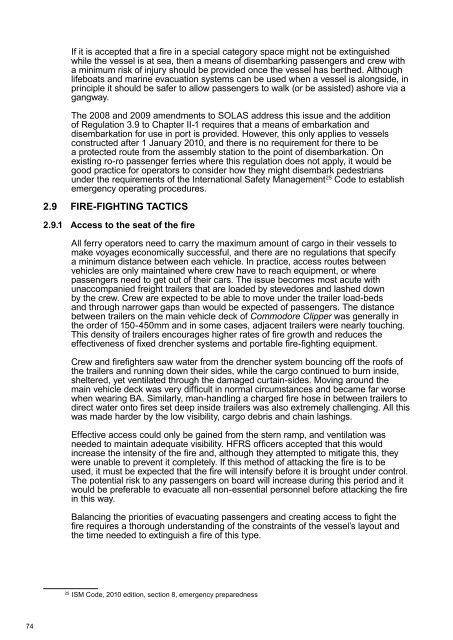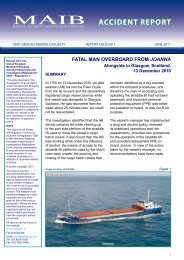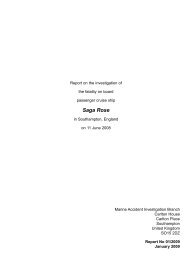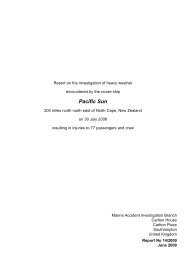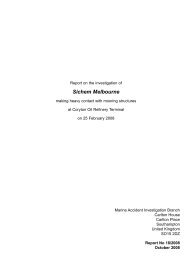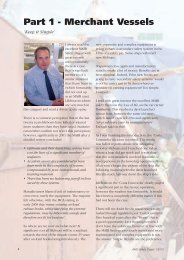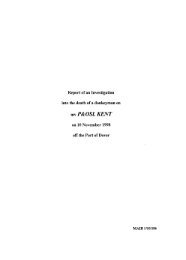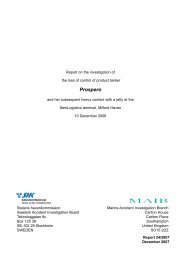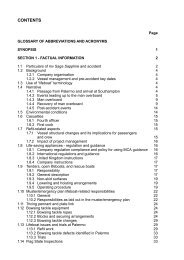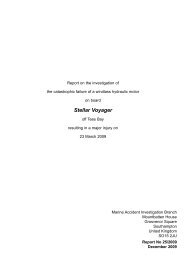Commodore Clipper - Marine Accident Investigation Branch
Commodore Clipper - Marine Accident Investigation Branch
Commodore Clipper - Marine Accident Investigation Branch
You also want an ePaper? Increase the reach of your titles
YUMPU automatically turns print PDFs into web optimized ePapers that Google loves.
74<br />
If it is accepted that a fire in a special category space might not be extinguished<br />
while the vessel is at sea, then a means of disembarking passengers and crew with<br />
a minimum risk of injury should be provided once the vessel has berthed. Although<br />
lifeboats and marine evacuation systems can be used when a vessel is alongside, in<br />
principle it should be safer to allow passengers to walk (or be assisted) ashore via a<br />
gangway.<br />
The 2008 and 2009 amendments to SOLAS address this issue and the addition<br />
of Regulation 3.9 to Chapter II-1 requires that a means of embarkation and<br />
disembarkation for use in port is provided. However, this only applies to vessels<br />
constructed after 1 January 2010, and there is no requirement for there to be<br />
a protected route from the assembly station to the point of disembarkation. On<br />
existing ro-ro passenger ferries where this regulation does not apply, it would be<br />
good practice for operators to consider how they might disembark pedestrians<br />
under the requirements of the International Safety Management 25 Code to establish<br />
emergency operating procedures.<br />
2.9 FIRE-FIGHTING TACTICS<br />
2.9.1 Access to the seat of the fire<br />
All ferry operators need to carry the maximum amount of cargo in their vessels to<br />
make voyages economically successful, and there are no regulations that specify<br />
a minimum distance between each vehicle. In practice, access routes between<br />
vehicles are only maintained where crew have to reach equipment, or where<br />
passengers need to get out of their cars. The issue becomes most acute with<br />
unaccompanied freight trailers that are loaded by stevedores and lashed down<br />
by the crew. Crew are expected to be able to move under the trailer load-beds<br />
and through narrower gaps than would be expected of passengers. The distance<br />
between trailers on the main vehicle deck of <strong>Commodore</strong> <strong>Clipper</strong> was generally in<br />
the order of 150-450mm and in some cases, adjacent trailers were nearly touching.<br />
This density of trailers encourages higher rates of fire growth and reduces the<br />
effectiveness of fixed drencher systems and portable fire-fighting equipment.<br />
Crew and firefighters saw water from the drencher system bouncing off the roofs of<br />
the trailers and running down their sides, while the cargo continued to burn inside,<br />
sheltered, yet ventilated through the damaged curtain-sides. Moving around the<br />
main vehicle deck was very difficult in normal circumstances and became far worse<br />
when wearing BA. Similarly, man-handling a charged fire hose in between trailers to<br />
direct water onto fires set deep inside trailers was also extremely challenging. All this<br />
was made harder by the low visibility, cargo debris and chain lashings.<br />
Effective access could only be gained from the stern ramp, and ventilation was<br />
needed to maintain adequate visibility. HFRS officers accepted that this would<br />
increase the intensity of the fire and, although they attempted to mitigate this, they<br />
were unable to prevent it completely. If this method of attacking the fire is to be<br />
used, it must be expected that the fire will intensify before it is brought under control.<br />
The potential risk to any passengers on board will increase during this period and it<br />
would be preferable to evacuate all non-essential personnel before attacking the fire<br />
in this way.<br />
Balancing the priorities of evacuating passengers and creating access to fight the<br />
fire requires a thorough understanding of the constraints of the vessel’s layout and<br />
the time needed to extinguish a fire of this type.<br />
25 ISM Code, 2010 edition, section 8, emergency preparedness


